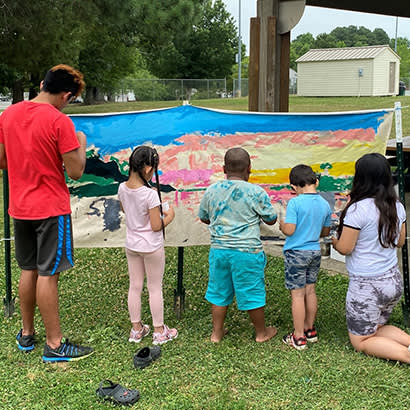
For an enhanced digital experience, read this story in the ezine.
What does creating art access through a park and recreation department look like? Simply stated, it is taking an art medium directly to a community that otherwise may not have access to hands-on art education. Historically, art has been — and continues to be — a foundational layer in world culture. Think of the volume of art that impacts us daily: listening to music on the ride to work, drinking out of a hand-thrown mug, scrolling through social media filled with digital designs, or appreciating a public mural. All bring expression, joy and enhancement to what would otherwise be a very mundane existence. Its creation is not limited to only certain members of the community. Art is influenced and contributed to by all people, and everyone deserves the chance to create their stamp on the art world.
In 2017, the University of Pennsylvania released a study on cultural art integration into neighborhoods. The research emphasized that the presence of cultural resources in neighborhoods has “a significant positive impact on a neighborhood’s health, the outcomes of its schools, and its crime rate,” and found:
- 14 percent decrease in child abuse or neglect
- 5 percent decrease in obesity
- 18 percent decrease in serious crime rates
- 18 percent increase in children’s math and reading exam scores
“Although low- and moderate-income neighborhoods have relatively few cultural resources, it’s these neighborhoods where [the] strongest connection between culture and social [well-being is found],” states the study report.
Recognizing the connection between culture and the effect it can have on social well-being, the park and recreation field can clearly support art access programming in alignment with NRPA’s pillars of health and wellness and equity. Departments should research population demographics to identify where low-income participants are located by neighborhood and what art education services are offered already through local organizations, then survey the identified neighborhoods to determine their interests. Every program will be unique and may include creating new partnerships; introducing pop-up art stations in parks or on trails; hosting a special event, like “Art in the Park”; and going into local schools or taking the program directly into apartment complexes or neighborhoods.
In James City County, Virginia, art access was advanced through a giant paint-by-numbers canvas set up in a local park that tapped into a pre-established grouping of participants, children at the park. Children learned about color wheels, paint mixing and painting on canvas. In less than two hours, more than 90 children were introduced to these basic art principles. One parent commented, “My children have never had the opportunity to paint like this. After this activity, my children want to paint at home and learn more.”
Do you have a neighborhood of community members who are more interested in music? Casey Wood at E.C. Glass High School in Lynchburg, Virginia, saw this exact need and created two classes to address it. He established the Rock Band program and a Hip Hop curriculum to allow students the opportunity to learn and express themselves through their own music.
Another example involves a mural at a local community recreation center. Children from Lynchburg participated in an activity in which they identified what parks and recreation meant to them and worked with staff to create a mural for the base of a recreation center.
Art access doesn’t have to be complicated — it just needs to reach the community. As park and recreation professionals, we are tasked with creating art and cultural opportunities locally, especially for those lacking resources, because as recognized in the 1948 Universal Declaration of Human Rights, culture is a right, not a privilege.
Rachel Smith is Operations Manager at James City County Parks and Recreation.

